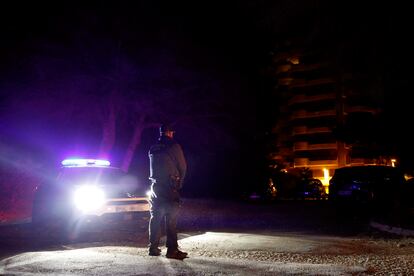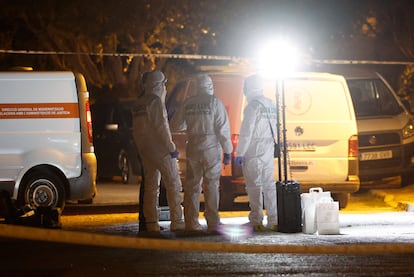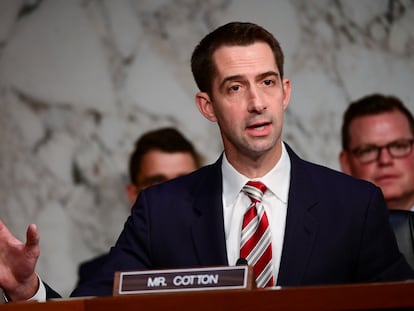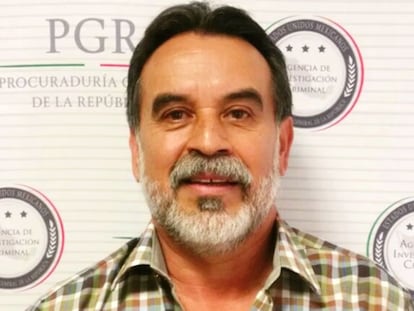Colombian cartel vendetta culminates in a massacre in Spain
The deaths of Roberto Vega Daza and two other men in Valencia are thought to be connected to a dispute between a Barranquilla crime family and a gang known as Los Costeños

It is Tuesday, February 27, and it is already dark. Civil Guard agents and the Valencia police find an abandoned car in the parking lot of a residential building in the district of El Saler, an area with little traffic near the Gola de Pujol, where the Albufera lake opens onto the Mediterranean Sea. Inside the vehicle they found three bodies, which displayed signs of having been shot to death. The deceased were of Colombian nationality, and the Spanish authorities have not yet provided their identities. But South American media have been able to identify one of them: Roberto Vega Daza, the leader of a criminal gang that has been committing felonies in the Colombian Caribbean for years.
On the other side of the Atlantic, almost at the same time as the massacre, a man dressed all in black approaches a house in the Colombian city of Barranquilla. He pulls out a can of spray paint and, in big red letters, writes on the doorway: “Game over Vega.” That night there is a party. In a high-class neighborhood, Villa Campestre, residents light up the sky with a rain of fireworks. They are celebrating, according to several sources, the death of the last living Vega Daza.
Roberto Vega Daza, 33, left Colombia a few months ago fleeing a criminal vendetta, Diógenes Rosero, director of the Atlantic Coast Forum, an organization that promotes democracy in the Caribbean region of the country, told this newspaper. The vendetta, says Rosero, originated on an October afternoon in 2022.

The origin of the vendetta
It is Sunday. Jonathan Ospino, the son of one of the leaders of a local gang known as Los Costeños, is celebrating his 21st birthday. He is dressed for an unforgettable day in a white T-shirt and black pants. The El Mediterrané estate, north of Barranquilla, is filled with important people: the capos of several drug-trafficking groups, businessmen from the region, and even public officials, according to two sources who prefer to remain anonymous for their safety. Also there is Roberto Vega Daza, whose life is about to change dramatically.
The party does not go as planned. At 7 a.m., after hours of traditional vallenato music and alcohol, a gunfight breaks out. The images published on social networks show a scene of absolute chaos. Attendees hide behind sound equipment, white chairs are thrown everywhere, a symphony of bullets fills the air. It is not known exactly why the fight started, but by the time it is over three people are dead: an attendee, an escort for the Vega Daza family, and Jonathan Ospino. The person accused of killing him is Roberto Vega Daza.
Vega Daza escapes in a white Toyota pickup truck. Ospino’s relatives shoot at the vehicle but fail to stop it as the van is armored. Vega Daza survives. He was arrested several hours later, but the Colombian authorities released him shortly thereafter. Faced with what they see as a lack of justice, Los Costeños vowed to take revenge. They put a price on his head and those of his relatives: $500,000, according to several sources.
😱 ENCAPUCHADOS ANUNCIAN QUE AHORA VAN POR LOS COLABORADORES DEL CLAN VEGA-DAZA.
— Primero Barranquilla (@primeronoticiaa) July 4, 2023
Hombres encapuchados advirtieron que varios empresarios de Barranquilla serían colaboradores de los Vega-Daza, asesinados en Villa Campestre y que ahora correrán la misma suerte de sus socios. pic.twitter.com/SV2MOJWl8C
The Vega Daza massacre
That revenge is carried out eight months later, on June 29, 2023. The Vega Dazas know they are in danger. Someone in Barranquilla has been pasting posters on poles bearing photographs of them and the caption: “Most wanted, criminal gang.” According to a police report, that day Roberto, his father Rafael Kike Vega Cuello, and his brothers Ronald and Ray, were leaving their house. Suddenly, men climbed onto the walls and roof and opened fire on them. They even threw a grenade. The father and two brothers were killed on the spot. Roberto, wounded in the left leg, managed to escape again and was taken to a nearby clinic.
Los Costeños took responsibility for the attack in a video posted on social networks. “This action was the consequence of a society tired of the outrages caused by the Vega clan,” said three hooded men, dressed entirely in black. “They were dedicated to stealing property, money, drugs, and extorting people, who got tired and united to put an end to these people,” they continued. Finally, they left a message for those close to Roberto: “Let it be clear to them that all his collaborators are on the same path, and anyone who wants to continue at Roberto Vega’s side.”
Vega Daza fled Colombia shortly after the ambush. Some sources placed him in Venezuela, others in Mexico. However, he ended up in Valencia, one of the main entry points for cocaine into Spain, where his life was eventually taken. Spanish authorities have not yet determined the motive behind the crime. No arrests have been made. His Colombian enemies finally caught up with him, sources familiar with the criminal world of Barranquilla tell this newspaper.
Although the Vega Dazas have been killed, it is hard for these sources to believe that the vendetta is over. Roberto is survived by his wife and children, as well as a large family in a city that experiences permanent violence. Throughout their 25 years in business, the Vega Dazas have had links to paramilitary groups, the North Coast Cartel — which ruled the Caribbean during the 1980s and 1990s — and have waged wars with numerous criminal organizations. More recently, they have had disputes with Los Costeños and Colombia’s largest drug-trafficking group, the Gulf Clan, among others.
With or without Vega Daza’s associates, violence will not stop in Barranquilla. The city of nearly three million inhabitants is mired in an urban war between various gangs that leaves a relentless trail of death in its wake: there were 733 homicides in 2023. Luis Trejos, a professor of political science at the Universidad del Norte, explained to this newspaper in January that a struggle for power has taken over the south of the city. “It is a war between different gangs for control of as much territory as possible with the aim of obtaining profits through extortion and micro-trafficking, among other things.” The main actors are the Gulf Clan, Los Rastrojos Costeños, Los Pepes and, precisely, Los Costeños.
Sign up for our weekly newsletter to get more English-language news coverage from EL PAÍS USA Edition
Tu suscripción se está usando en otro dispositivo
¿Quieres añadir otro usuario a tu suscripción?
Si continúas leyendo en este dispositivo, no se podrá leer en el otro.
FlechaTu suscripción se está usando en otro dispositivo y solo puedes acceder a EL PAÍS desde un dispositivo a la vez.
Si quieres compartir tu cuenta, cambia tu suscripción a la modalidad Premium, así podrás añadir otro usuario. Cada uno accederá con su propia cuenta de email, lo que os permitirá personalizar vuestra experiencia en EL PAÍS.
¿Tienes una suscripción de empresa? Accede aquí para contratar más cuentas.
En el caso de no saber quién está usando tu cuenta, te recomendamos cambiar tu contraseña aquí.
Si decides continuar compartiendo tu cuenta, este mensaje se mostrará en tu dispositivo y en el de la otra persona que está usando tu cuenta de forma indefinida, afectando a tu experiencia de lectura. Puedes consultar aquí los términos y condiciones de la suscripción digital.
More information
Archived In
Últimas noticias
Most viewed
- Reinhard Genzel, Nobel laureate in physics: ‘One-minute videos will never give you the truth’
- Oona Chaplin: ‘I told James Cameron that I was living in a treehouse and starting a permaculture project with a friend’
- Pablo Escobar’s hippos: A serious environmental problem, 40 years on
- Why we lost the habit of sleeping in two segments and how that changed our sense of time
- Chevy Chase, the beloved comedian who was a monster off camera: ‘Not everyone hated him, just the people who’ve worked with him’











































